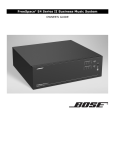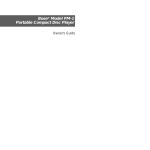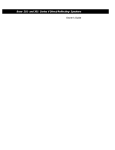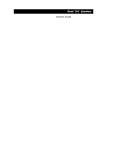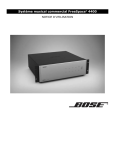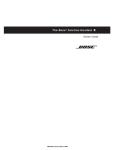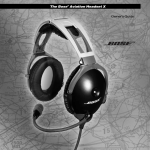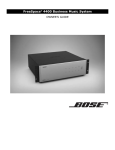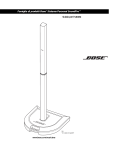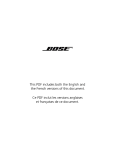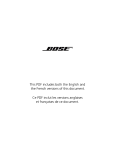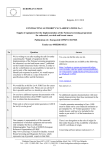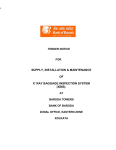Download Bose FREESPACE E4 User's Manual
Transcript
FreeSpace® E4 Series II Business Music System OWNER’S GUIDE DECLARATION OF CONFORMITY We, the offerer: Bose Corporation The Mountain Framingham, MA 01701-9168 USA acknowledge our sole responsibility, that the product, Kind of equipment: Amplifier Type designation: FreeSpace® E4 Series II business music system in accordance with EMC Directive 89/336/EEC and Article 10(1) of the Directive, is in compliance with the following norm(s) or document(s): Technical Regulations: EN 55103-1(E2)/EN 55103-2(E2) Report Number: EMC.N9C.02.170.1 Test laboratory: Bose Corporation 1 New York Avenue Framingham, MA 01701 USA and in accordance with the Low Voltage Directive 73/23/EEC, is in compliance with the following norm(s) or document(s): Technical Regulations: Certificate/Report Number: Accredited test laboratory: EN 60065/IEC 60065 S2171542/E2171622 TÜV Rheinland Sicherheit und Umweltschutz GmbH Am Grauen Stein, D-51101 Köln, Germany 07/10/2004 Bose B.V. Nijverheidstraat 8, 1135 The Netherlands Nic Merks Vice President, Europe Manufacturer’s authorized EU representative ©2004 Bose Corporation. No part of this work may be reproduced, modified, distributed or otherwise used without prior written permission. 2 of 80 Contents 1.0 E4 Introduction . . . . . . . . . . . . . . . . . . . . . . . . . . . . 1.1 The Bose® FreeSpace® E4 Series II business music system . . . . . . . . . . . . . . . . . . . . . . . . 1.2 E4 system accessories . . . . . . . . . . . . . . . . . . . 1.3 FreeSpace Installer™ software . . . . . . . . . . . . . 13 2.0 Designing with the E4 System . . . . . . . . . . . . . . . . . 2.1 Introduction . . . . . . . . . . . . . . . . . . . . . . . . . . . . 2.2 Basic design steps . . . . . . . . . . . . . . . . . . . . . . 2.2.1 Step 1 – Determine source routing . . . . . . 2.2.2 Step 2 – Determine Auto Volume requirements . . . . . . . . . . . . . . . . . . . . 2.2.3 Step 3 – Determine volume control requirements . . . . . . . . . . . . . . . . . . . . 2.2.4 Step 4 – Determine the speaker requirements . . . . . . . . . . . . . . . . . . . . 2.2.5 Step 5 – Determine the E4 requirements . 2.3 Auto Volume layout examples . . . . . . . . . . . . . . 15 15 15 15 3.0 E4 Hardware Description . . . . . . . . . . . . . . . . . . . . 3.1 Front panel . . . . . . . . . . . . . . . . . . . . . . . . . . . . 3.1.1 Controls . . . . . . . . . . . . . . . . . . . . . . . . . . 3.1.2 Indicators . . . . . . . . . . . . . . . . . . . . . . . . . 3.2 Rear panel . . . . . . . . . . . . . . . . . . . . . . . . . . . . . 3.2.1 System controls . . . . . . . . . . . . . . . . . . . . 3.2.2 Audio source inputs . . . . . . . . . . . . . . . . . 3.2.3 Amplifier outputs . . . . . . . . . . . . . . . . . . . 3.2.4 AC power . . . . . . . . . . . . . . . . . . . . . . . . . 23 23 23 23 24 24 24 24 24 4.0 Hardware Installation . . . . . . . . . . . . . . . . . . . . . . . . 4.1 Introduction . . . . . . . . . . . . . . . . . . . . . . . . . . . . 4.2 Included accessories . . . . . . . . . . . . . . . . . . . . 4.3 Placement guidelines . . . . . . . . . . . . . . . . . . . . 4.4 Shelf mounting the E4 unit . . . . . . . . . . . . . . . . 4.5 Rack mounting the E4 unit . . . . . . . . . . . . . . . . 4.6 Installing accessories . . . . . . . . . . . . . . . . . . . . 4.6.1 Sensing microphones . . . . . . . . . . . . . . . . 4.6.2 User interfaces . . . . . . . . . . . . . . . . . . . . . 4.7 System wiring . . . . . . . . . . . . . . . . . . . . . . . . . . 4.7.1 Auto volume microphone inputs . . . . . . . 4.7.2 Serial data communications . . . . . . . . . . . 4.7.3 User interface connections . . . . . . . . . . . . 4.7.4 Remote standby switch . . . . . . . . . . . . . . 4.7.5 LINE 1/LINE 2 source input . . . . . . . . . . . 4.7.6 AUX MIC/LINE 3 source input . . . . . . . . . 4.7.7 PAGE/MIC/LINE 4 source input . . . . . . . . 4.7.8 DIRECT IN/CONTROL source input . . . . . 4.7.9 Amplifier ZONE OUT outputs . . . . . . . . . . 4.7.10 Output voltage setting (70/100V) . . . . . . 4.7.11 ZONE 4 LINE OUT output . . . . . . . . . . . 4.8 AC power connections . . . . . . . . . . . . . . . . . . . 25 25 25 25 25 26 27 27 27 29 29 29 29 29 30 30 31 31 32 32 33 33 13 13 14 15 18 18 19 20 5.0 Using FreeSpace® Installer™ Software . . . . . . . . . . 5.1 Installing the software . . . . . . . . . . . . . . . . . . . . 5.2 Connecting to the E4 system . . . . . . . . . . . . . . 5.2.1 No hardware detected . . . . . . . . . . . . . . . 5.2.2 Incompatible microcontroller code . . . . . 5.2.3 Sample design files . . . . . . . . . . . . . . . . . 5.3 The Installer™ software user interface . . . . . . . 5.4 Set Up Hardware mode . . . . . . . . . . . . . . . . . . 5.5 Set Up Schedule mode . . . . . . . . . . . . . . . . . . . 5.5.1 Setting the clock . . . . . . . . . . . . . . . . . . . 5.5.2 Adding events . . . . . . . . . . . . . . . . . . . . . 5.5.3 Viewing and changing event settings . . . 5.5.4 Removing events from the list . . . . . . . . . 5.6 Service Hardware mode . . . . . . . . . . . . . . . . . . 34 34 34 36 36 36 37 39 40 41 41 42 42 43 6.0 E4 System Setup . . . . . . . . . . . . . . . . . . . . . . . . . . 6.1 Introduction . . . . . . . . . . . . . . . . . . . . . . . . . . . . 6.2 Connecting your PC to an E4 system . . . . . . . . 6.3 System setup procedure . . . . . . . . . . . . . . . . . 6.3.1 Output gain . . . . . . . . . . . . . . . . . . . . . . . 6.3.2 Zone setup . . . . . . . . . . . . . . . . . . . . . . . . 6.3.3 Input gain . . . . . . . . . . . . . . . . . . . . . . . . . 6.3.4 Source assign . . . . . . . . . . . . . . . . . . . . . 6.3.5 Source EQ . . . . . . . . . . . . . . . . . . . . . . . . 6.3.6 Page set up . . . . . . . . . . . . . . . . . . . . . . . 6.3.7 Zone EQ . . . . . . . . . . . . . . . . . . . . . . . . . . 6.3.8 Dynamic EQ . . . . . . . . . . . . . . . . . . . . . . . 6.3.9 Auto Volume . . . . . . . . . . . . . . . . . . . . . . . 44 44 44 45 45 46 47 49 50 50 52 53 53 7.0 User Interface Operation . . . . . . . . . . . . . . . . . . . . . 7.1 Enabling keypad operation . . . . . . . . . . . . . . . . 7.2 Turning the system on . . . . . . . . . . . . . . . . . . . 7.3 Standard user interface operation . . . . . . . . . . 7.4 Auto Volume user interface operation . . . . . . . 7.5 Multi-zone paging user interface operation . . . 59 59 59 59 60 61 8.0 E4 System Troubleshooting . . . . . . . . . . . . . . . . . . 8.1 Introduction . . . . . . . . . . . . . . . . . . . . . . . . . . . . 8.2 E4 hardware indicators . . . . . . . . . . . . . . . . . . . 8.2.1 Normal operation . . . . . . . . . . . . . . . . . . . 8.2.2 System fault . . . . . . . . . . . . . . . . . . . . . . . 8.2.3 Amplifier fault . . . . . . . . . . . . . . . . . . . . . . 8.2.4 Input clipping . . . . . . . . . . . . . . . . . . . . . . 8.2.5 Direct input is active . . . . . . . . . . . . . . . . 8.2.6 No STANDBY and SYSTEM indicators . . 8.3 FreeSpace® E4 system Error Log . . . . . . . . . . . 8.3.1 Contents of the Error Log . . . . . . . . . . . . 8.3.2 Hardware configuration . . . . . . . . . . . . . . 8.3.3 Power-on self-test results . . . . . . . . . . . . 8.3.4 Amplifier alarms . . . . . . . . . . . . . . . . . . . . 8.3.5 Solving faults reported in the Error Log . . 62 62 62 62 62 63 64 64 64 65 65 65 65 66 67 11 of 80 Contents 8.4 Common problems . . . . . . . . . . . . . . . . . . . . . . 8.4.1 Communications port error . . . . . . . . . . . 8.4.2 No audio in zone . . . . . . . . . . . . . . . . . . . . 8.4.3 User interface keypads do not operate correctly . . . . . . . . . . . . . . . . . 8.4.4 Bad sound in a zone . . . . . . . . . . . . . . . . . 8.4.5 Auto Volume does not calibrate . . . . . . . . 8.5 Customer support . . . . . . . . . . . . . . . . . . . . . . . 8.5.1 Technical assistance . . . . . . . . . . . . . . . . 8.5.2 Reporting software bugs and issues . . . . 68 68 68 69 69 70 70 70 70 9.0 Restoring E4 Microcontroller Code . . . . . . . . . . . . . 72 10.0 Technical Specifications . . . . . . . . . . . . . . . . . . . . 10.1 Power amplifier . . . . . . . . . . . . . . . . . . . . . . . . 10.2 Digital signal processing . . . . . . . . . . . . . . . . . 10.3 Front panel indicators and control connections . . . . . . . . . . . . . . . . . . . . . . . . . . 10.4 Rear panel inputs, outputs, and controls . . . . 10.5 E4 system serial data commands . . . . . . . . . . 10.6 FreeSpace® Installer™ Design File Compatibility . . . . . . . . . . . . . . . . . . . . . . . . . 74 74 74 74 74 74 76 12 of 80 8.0 E4 System Troubleshooting 8.1 Introduction This section provides troubleshooting guidelines to use for solving any problems you may encounter while installing and servicing E4 systems. 8.2 E4 hardware indicators To determine the severity of the error, cycle the E4 unit power off and back on again. If the SYSTEM STATUS indicator is now off, the E4 system has logged an error, but is still operational. When you check the error log using the FreeSpace® Installer™ software you can identify the cause of the error, and determine an appropriate solution. 8.2.1 Normal operation SYSTEM STATUS Indicator is red These are the indications of normal operation. AMP OUTPUTS STANDBY Unlit 1 2 3 4 SYSTEM STATUS 4 DIRECT INPUT SYSTEM STATUS Green AMP OUTPUTS Unlit or Green STANDBY AUDIO SOURCES 1 2 3 AUDIO SOURCES Unlit, Amber, or Green Have you cycled the E4 in and out of STANDBY? No Switch the E4 unit to STANDBY and then back to active again. If the SYSTEM STATUS is green, the system may have logged an error. Check the Installer™ software Error Log. Yes DIRECT INPUT Unlit 8.2.2 System fault A red SYSTEM STATUS LED indicates that the E4 received an error from one of its many internal components. A red SYSTEM STATUS LED after AC power is switched on may be caused by: Have you cycled the E4 power on and off? No • A Power-On Self-Test failure 1. Switch the E4 unit to STANDBY. 2. Set the POWER switch to OFF. 3. Wait for STANDBY indicator to turn off. 4. Set the POWER switch to ON. 5. Press the STANDBY switch. Yes • A DSP error • The DSP is offline AMP OUTPUTS 1 2 3 4 SYSTEM STATUS 4 DIRECT INPUT STANDBY AUDIO SOURCES 1 2 3 System logged an error – Check the Installer™ software Error Log. Have you disconnected all input/output cables? Yes Contact Bose Customer Service. 62 of 80 No 1. Switch the E4 unit to STANDBY. 2. Set the POWER switch to OFF. 3. Disconnect all input/output signal cables. 4. Set the POWER switch to ON. 5. Press the STANDBY switch. 6. Reconnect one cable at a time and check the Error Log. 8.0 E4 System Troubleshooting 8.2.3 Amplifier fault The AMP OUTPUT LEDs work in pairs (1 and 2, 3 and 4) and indicate the operating status of the four amplifier output channels. AMP OUTPUT indicators are red Check for AMP OUTPUTS 1 2 3 4 2 3 • Shorted wiring • Overdriven amplifier (reduce output gain) STANDBY AUDIO SOURCES 1 SYSTEM STATUS 4 DIRECT INPUT • Transformer saturation • Entry in Installer™ software error log Has the E4 unit shut down during operation? Yes • Check the number of loudspeakers connected to the E4 unit. Verify that the total sum of loudspeaker taps connected to the E4 unit does not exceed 400W. • Verify that there are no shorts on the speaker output lines. No When an amplifier fault occurs, the amplifier mutes its outputs and indicates an error. After a short period of time the amplifier will try to operate again. If the fault condition persists, the amplifier will attempt to restart six times, after which it will remain muted. Amplifier faults are typically caused by a shorted speaker line, an overdriven amplifier, or a saturated output transformer. • To check for a shorted speaker line, remove the speaker connection from the amplifier channel. If this resolves the problem, locate and correct the shorted loudspeaker line. • To make sure that you are not overdriving the E4 output, change to a different source. If the problem no longer exists, use the Installer™ software to reduce the input level of the original source that was overdriving the output. • To make sure an output transformer is not being saturated, check to see if the correct speaker EQ setting is selected. Is SYSTEM STATUS indicator green? Yes Does the Installer™ software Error Log list any amplifier faults? No If none of these actions solve the problem, read the instructions in the following flow chart or check the error log using the Installer™ software. Contact Bose Customer Service. 63 of 80 No • Switch POWER to OFF. • Disconnect the load and switch POWER to ON. • Verify that there are no shorts on the speaker output lines. Yes See amplifier fault troubleshooting section for course of action. 8.0 E4 System Troubleshooting 8.2.4 Input clipping 8.2.6 No STANDBY and SYSTEM indicators If clipping is occurring at the input of an amplifier channel, the source LED will blink red. AMP OUTPUTS 1 2 3 4 SYSTEM STATUS 4 DIRECT INPUT STANDBY AUDIO SOURCES 1 2 3 STANDY & SYSTEM LEDs are off - AC power is on Is E4 unit plugged into an AC source? If this fault occurs: No Plug the E4 unit into an AC receptacle. Yes • Reduce the output gain of the source, or • Using the Installer™ software, reduce the input gain for the channel that is clipping. Is the E4 POWER switch set to ON? 8.2.5 Direct input is active No Set E4 POWER switch to ON. If the DIRECT INPUT LED is red: • Check that the DIRECT INPUT/CONTROL contact closure is in the closed position. Yes • Check the device to which this input is connected. AMP OUTPUTS 1 2 3 4 2 3 Is STANDBY indicator on? Yes Press the STANDBY switch on the E4 front panel. STANDBY AUDIO SOURCES 1 SYSTEM STATUS 4 DIRECT INPUT No Yes Is SYSTEM STATUS indicator red? • Connect your PC to the E4 unit and read the Error Log. • Check the results of the Power On self test (POST). • Use the POST troubleshooting chart for course of action. No Is the unit properly configured for the line voltage? Yes Contact Bose Customer Service. 64 of 80 No • Set E4 POWER switch to OFF. • Verify that E4 unit is configured for the correct AC line voltage. • Verify that the fuse is good. • Verify that the AC receptacle is live. • Set POWER switch to ON. 8.0 E4 System Troubleshooting 8.3 FreeSpace® E4 system Error Log • Host controller – The host controller monitors and controls the operation of the E4 hardware. A host controller failure will cause the message, “Power-on self-test incomplete” to appear in the host controller test section. The failure type for a host controller is an SRAM address failure. If this occurs, contact Bose Customer Service. See “Customer support” on page 70. The FreeSpace E4 system Error Log is displayed when the Installer™ software is in the Service Hardware mode. 8.3.1 Contents of the Error Log The Error Log displays E4 system hardware version numbers and records all alarms and their causes as shown in the following example. Hardware version numbers Type of alarm Name of test Test results Bose® FreeSpace E4 Series II Error Log ------------------------------------------------Microcontroller: v1.0.0.64 DSP: v1.0.71.0 Peripheral: v1.0.0.10 Lower Amplifier: v1.0.0.14 Upper Amplifier: v1.0.0.14 ------------------------------------------------power-on self-test alarm (ok) 2002/12/31 23:59 host controller test: [OK] host controller flash test: [OK] peripheral controller test: DSP test: 1 upper amplifier test: [OK] • Flash memory test – The flash memory contains the configuration, design file, and system event schedule. A flash failure will cause the message, “Power-on sel-test incomplete” to appear in the host controller flash test section. If this occurs, contact Bose Customer Service. See “Customer support” on page 70. • Peripheral controller – The peripheral controller monitors contact closures, front panel connections and user interface connections for incoming event messages. Any failures in these areas will cause the message, “Power-on self-test incomplete” to appear in the peripheral controller flash test section. If a 12C, or code failure occurs, contact Bose Customer Service. See “Customer support” on page 70. If a user interface failure occurs, check the user interface wiring for shorts. • DSP test – The DSP performs all signal processing and routing functions. If a DSP error occurs, contact Bose Customer Service. See “Customer support” on page 70. 8.3.2 Hardware configuration The E4 system hardware version numbers appear at the top of the Error Log listing. These are the version numbers of the software installed in the E4 hardware at the time of manufacture. These version numbers do not pertain to the FreeSpace Installer™ software installed on your PC. 8.3.3 Power-on self-test results The power-on-self test (POST) results are only displayed when an error has occurred. The POST test checks the basic operation of the E4 hardware to determine if it is capable of properly performing audio processing and amplification. During the POST test, six major components of the hardware are tested. • Upper and lower amplifier test – The upper and lower amplifier test determines if the amplifiers are operating properly. An amplifier failure will cause the message, “Power-on self-test incomplete” to appear in the upper or lower amplifier section of the POST test results. If a 12C, or code failure occurs, contact Bose Customer Service. See “Customer support” on page 70. Additional details on the exact cause of an amplifier failure can be found in the amplifier section of the Error Log. • Front panel board test – The front panel board test determines if the USB port is working properly. A USB failure will cause the message, “Power-on self-test incomplete” to appear in this section of the POST results. If a USB failure occurs, contact Bose Customer Service. See “Customer support” on page 70. 65 of 80 Programmer’s Note: The USB port is not currently used for communication with the E4. If a USB failure occurs, the E4 will still function normally for audio processing and amplification. 8.0 E4 System Troubleshooting 8.3.4 Amplifier alarms Amplifier alarms – using output voltage and current Each amplifier section monitors its own operation and performance. If a fault condition occurs, it is reported in the Amplifier Alarm section of the Error Log. Upper amplifier alarms affect channels 1 and 2, and Lower amplifier alarms affect channels 3 and 4. Reviewing the output voltage and current can help to diagnose a problem. Compare the output voltage and current for each of the two amplifier outputs to determine the nature of the problem. High Voltage (>20V) The amplifier section of the alarm log indicates the following: • Alarm type – The generated alarm type is the first item. • Amplifier status – When an alarm is generated, the amplifier reports its current operating status for diagnostic purposes. The following items are reported in the status: Date & Time: Date and time when alarm condition occurred. Rail Voltage: The amplifier positive and negative rail voltages. Normally, the amplifier rail voltage should be between 100V and 190V. Voltages outside this range will cause the amplifier to shut down. In the 70V mode, a normal rail voltage is approximately 125V. In the 100V mode, a normal rail voltage is approximately 165V. Temperature: The internal operating temperature of the amplifier. Normally, this will be between 0 and 160 degrees Fahrenheit. Output Voltage: The actual output voltage of the amplifier at the time of the alarm. Output Current: The actual output current of the amplifier at the time of the alarm. Input Status: The status of the input signal to the amplifier. Possible status messages are DC sense fault, amplifier module fault, AC power fault, sleep mode, high-frequency sense fault, and retry fault. Output Status: The status of the amplifier output at the time of the alarm. Possible status messages are “amplifier module muted,” and “speaker relay off.” Fan Speed: The fan speed at the time of the alarm. Operating Mode: The current setting of the output voltage select switch, 70V or 100V. Low Voltage (<20V) High Current (>2A) Driving an impedance <12Ω • Reduce total speaker load • Check for partial short of speaker line High Current (<1A) Loudspeaker transformer saturation at low frequency • Check for proper Speaker EQ setting • Set Speaker EQ to high-pass filter Short on speaker line Amplifier alarms – using rail voltage Normally, the amplifier rail voltage should be between 100V and 190V. In the 70V mode a normal rail voltage is approximately 125V. In the 100V mode a normal rail voltage is approximately 165V. By comparing the + and – rail voltages, you can determine if you are driving an impedance which is too low (<12Ω). In this case the difference between the two rails will probably be greater than 20%. If one of the rails shows a voltage, and the other does not, the amplifier should be replaced. As you review all alarm records you can compare the plus rail voltage in each of the status sections. For example, a drop of 50% in one status could indicate a brownout condition occurred. Amplifier alarms – input and output status The Input and Output Status sections display the fault condition which caused the alarm and the current status of the amplifier output. 66 of 80 8.0 E4 System Troubleshooting A number of fault conditions can be displayed in the Input Status section: DC Sense Fault: A power supply fuse, output FET, amplifier module, or some combination of the above has blown. The unit should be replaced. Amplifier Module Fault: When the Amplifier Module fault occurs by itself it can be caused by any of the following: • Shorted speaker line – Check the loudspeaker line for shorts. • System power exceeds 400W – Check that system power does not exceed 400W. Generally, this fault results in a one-time 3-second dropout. If, when the amplifier tries to restart after 3 seconds, the excess HF is still present, the amp (and speaker relay) will remain off for another 3 seconds and the loop repeats. Six of these in a row will cause the amp to shut down, and will trigger a Retry Fault. When this fault occurs you can check your program material for excessive high-frequency content, or for a potential ground loop which has created an oscillation internal to the E4 unit. You can also reduce the output gain for this amplifier zone in an attempt to reduce the high-frequency energy going to the amplifier. Retry Fault: The amplifier has tried to start up or recover from a fault condition at least six times. When this occurs, you will need to place the E4 unit in standby and then press the STANDBY button again to clear the fault, at which time the E4 unit will again try to start up. • Speaker transformer saturation – Check that proper speaker EQ is being used or use a high-pass filter for speaker EQ. • Line voltage too high (surge) – Check Error Log for a rail voltage that exceeds 150V, in 70V mode, or 190V, in 100V mode. When this occurs you should check the alarm history section of the Amplifier Alarm to determine the exact fault type that triggered the Retry Fault. • Line voltage too low (brownout) – Check Error Log for a rail voltage which is lower than normal by at least 20%. • 70/100V mode switched with unit operating – Check that output voltage and AC input voltage selector are correct. • Blown power supply fuse (as opposed to AC line fuse) – Replace the E4 unit. AC Power Fault: Might be an AC line dropout or severe brownout, or simply AC power turned off without first placing the E4 in standby mode. You can check that the power has been removed from the E4, or that you experienced a power dropout. Sleep Mode: The host microcontroller has told the amplifier and power supply to turn off. This only occurs in conjunction with another alarm (usually AC power fault), because it in itself is not an alarm condition. When an AC power dropout occurs, the amplifier immediately shuts the amplifier and speaker relay off, then the other processing is shut down. This all happens fast enough to prevent data loss or corruption, and to prevent loud pops in the speakers. When this occurs you should check the alarm history to determine what other faults occurred at this time. Input and output alarm history This part of the Error Log displays the sequence of fault conditions where “0” is the initial fault reported followed by “1-6”. These occur over a very short period of time. 8.3.5 Solving faults reported in the Error Log When errors are reported in the Error Log, you can try to solve the problem by performing one of the following actions: • On the E4 rear panel, turn the POWER switch to OFF. Wait a few seconds and turn the POWER switch to ON. Then press STANDBY on the front panel. • On the E4 rear panel, turn the POWER switch to OFF. Disconnect all input/output signal cables. Wait a few seconds and turn the POWER switch to ON. Then press STANDBY on the front panel. Reconnect one cable at a time and check the Error Log. High-Frequency Sense Fault: This protection mode is designed to prevent damage to the amplifier or speakers from excessive high-frequency audio or ultrasonic energy. The amplifier is not capable of sustained operation at full power in the 10kHZ to 20kHz (+) range. 67 of 80 8.0 E4 System Troubleshooting 8.4 Common problems 8.4.2 No audio in zone 8.4.1 Communications port error If the system is powered on and operational, but there is no sound, check the following: When you receive the communications port error dialog, the FreeSpace® Installer™ software was not able to locate an E4 system on the COM 1 port. • Do the front panel LEDs indicate normal operation? • Is the source operating? • Is routing correct? • Is output gain correct? • Is the output gain muted? • Is cabling correct? No audio in zone. Are the AUDIO SOURCES indicators green? This normally occurs due to one of three reasons: No • Make sure that the audio sources are connected to the E4 LINE inputs and that there is an input signal from the source. • Using the Installer™ software, check that the input gain is raised. • Make sure the source is on. Yes • The PC and E4 are not connected via a “straight-wired” serial cable. • Another software application has control of the serial port. Applications such as the Palm OS, or other audio applications control the serial port while they are open. Close these applications and click the Try Again button. • The E4 is connected to another communications port. If this is the case you should select the appropriate COM port and click the Try Again button. Is AMP OUTPUT indicator red? Yes No Programmer’s Note: Before dismissing the “Choose COM port” dialog, select the COM 2 port and click Try Again. Not doing this will cause the COM 1 port to be locked. Are the AMP OUTPUTS indicators green? Yes Contact Bose Customer Service. 68 of 80 No The amplifier is in “protect” mode. Disconnect the load and see if the output indicator changes to green. If so: • Check for a short in the output line, • Make sure no small strands of wire are touching other wires, • Make sure speakers are functioning correctly, or • Using a voltmeter, check for a voltage drop in the power line when amplifier is being driven excessively hard. See amplifier fault troubleshooting section for course of action. 8.0 E4 System Troubleshooting 8.4.3 User interface keypads do not operate correctly 8.4.4 Bad sound in a zone • Check wiring of RJ-45 connectors. Bad sound • Check for breaks/shorts in cable. • Using the Installer™ software, check the Error Log for a peripheral controller error. User interface keypads exhibit strange behavior Is the sound unnatural? Yes Verify that the correct Speaker EQ is selected in the Installer™ software for that zone. Verify that the speakers are wired in phase. Check the rear panel markings. No Is keypad connected to the correct ZONE on the E4 unit? No Connect the keypad to the correct zone on the E4 unit. Is the AMP OUTPUT indicator flashing? Yes Yes Reduce the input gain using Installer™ software until the indicator is solid green. Yes Verify that the input source signal is clean. If source is from a mixer, decrease the mixer gain. No Is the keypad connector wiring correct? No Correct the keypad connector wiring. Are input and output indicators green and sound is distorted? Yes Are all sources to be controlled assigned to the ZONE? (Std. and AV keypad) No No Check source assignments using Installer™ software. Yes Is the page source No assigned to the ZONE? (Paging keypad only) Is the input signal clean at the E4 input? Check source assignments using Installer™ software. No Yes Verify source hardware settings Does the Installer™ Yes Error Log list any peripheral controller faults? See troubleshooting for the peripheral controller. No Contact Bose Customer Service. 69 of 80 Yes Verify that the loudspeakers are not being overdriven or are damaged. Verify that the total load impedance presented to the E4 output is within specified limits for the selected mode of operation. 8.0 E4 System Troubleshooting 8.4.5 Auto Volume does not calibrate 8.5.2 Reporting software bugs and issues Auto Volume calibration may fail if the process cannot obtain an adequate source level. This may be due to: Please email any problems, issues, or software bugs to your local Bose representative. Please include the following information: • Speakers are tapped too high • Software version • Maximum output gain is less than -20 dB • E4 Error Log file • Source is not operating • Computer make, model, and configuration (hard drive storage capacity, processor speed, and amount of installed RAM) • Source level is too low Calibration could also fail if the calculated loop gain is not within required limits. This may be due to: • Broken microphone cable • Speakers are not connected • Sensing microphone is not connected, or is connected to the wrong zone 8.5 Customer support • Description of the problem – Can it be reproduced? If so, what steps can be taken within the application to make the problem manifest itself? If possible, attach the Installer™ software diagnostic files. The Installer software creates three important diagnostic files (output, error, and log) each time the software runs. These files are distinct from the E4 Error Log file which refers to the hardware errors and can be accessed using the Service tab within the Installer™ software. The name of each Installer diagnostic file includes the date and time that Installer software was run. For example: 8.5.1 Technical assistance If you need further technical assistance, contact your local Bose representative, or send an email to the address for your area: FreeSpaceInstallerOutput-Oct 8, 2002 12_53_05 PM.txt North America FreeSpaceInstallerLog-Oct 8, 2002 12_53_05 PM.txt [email protected] Europe FreeSpaceInstallerErrors-Oct 8, 2002 12_53_05 PM.txt These files are automatically written in the “temporary file” directory of your computer’s operating system. Use the standard Windows “Search” of “Find” feature to look for files named [email protected] FreeSpaceInstallerOutput, FreeSpaceInstallerErrors, and FreeSpaceInstallerLog Asia, Australia, India and Middle East [email protected] on all local hard drives. This feature can be found in the Start menu of Windows 98, NT, 2000, or XP. Once the search is complete, sort the listing by date to show the diagnostic files most recently created by the Installer™ software. 70 of 80 8.0 E4 System Troubleshooting To find the temporary file directory… For Windows 2000, or Windows XP: 1. Right-click My Computer on the Windows desktop. 2. Select the Properties menu item. 3. Click the Advanced tab. 4. Click the Environment Variables... button. 5. Scroll down to the value of variable TEMP under “User variables”. If, and only if, it is not found there, look under System variables instead. For Windows NT: 1. Right-click My Computer on the Windows desktop. 2. Select the Properties menu item. 3. Click the Environment Variables tab. 4. Scroll down to the value of variable TEMP under User variables. If, and only if, it is not found there, look under System variables instead. For Windows 98 1. Click on the Start menu. 2. Select Run... 3. Type command and hit Enter. 4. Type echo %TEMP% and hit Enter. 5. Write down the displayed value of variable TEMP. 6. Type exit and hit Enter. Typical values for TEMP are C:\WINNT\TEMP, C:\windows\TEMP, C:\TMP, etc. Programmer’s Note: You may not see these files if the contents of the “tmp” file are not visible. Use the Show all files option in the Windows Tools/Folder Options menu. 71 of 80 9.0 Restoring E4 Microcontroller Code 6. Press and hold the Ctrl and Alt keys on your PC keyboard IMPORTANT! and click the (Flash Configuration) button. The Upload Microcontroller Code dialog appears: DO NOT use this procedure to upgrade the firmware in your FreeSpace® E4 Series II system to any version other than the version running at the time that the design file was created. The microcontroller code residing in the E4 system hardware can be restored using the Installer™ software. 1. Using the E4 front panel STANDBY button, place the unit in standby mode (the STANDBY indicator should be amber). 2. Press the STANDBY button again to place the unit in operating mode (the SYSTEM STATUS indicator should be green). 3. If not already done, connect your PC to the E4 unit using a serial data cable. 4. Launch the version of Installer software that was last used to configure the system. As the software activates the connection with the E4 unit, a status dialog window appears. Once the connection is made, the E4 front panel (block diagram) appears on your screen. 7. Locate the appropriate microcontroller code file in the installation directory on your computer. Typically, this file is located in, C:\Program Files\FreeSpace Installer 2.0\Firmware If the OUTPUT VOLTAGE of your E4 system is set to 70V, select, BoseE4Uctlr70V-#.#.#.# If the OUTPUT VOLTAGE of your E4 system is set to 100V, select, BoseE4Uctlr100V-#.#.#.# (#.#.#.# represents the code version number.) 5. Click the (Save File) button and save the design file to your PC. This ensures that all of your settings and events will be available later. 8. 72 of 80 When you are asked to confirm that you are about to upload new firmware, click Yes. 9.0 Restoring E-4 Microcontroller Code The firmware upgrade runs automatically and will notify you when it is complete. Once the upgrade is completed, select the Service Hardware mode and verify that the microcontroller version number is correct. For example: ------------------------------------------------Microcontroller: v1.0.0.64 DSP: v1.0.71.0 Peripheral: v1.0.0.10 Lower Amplifier: v1.0.0.14 Upper Amplifier: v1.0.0.14 ------------------------------------------------If you do not see the correct microcontroller version number, or if any of the other firmware version numbers are less than the values shown in this example, please contact your local Bose Customer Support representative. 9. Open the design file you saved in Step 6. Click the (Flash Hardware Configuration) button to restore your hardware configuration. 10. Perform an Auto Volume calibration for those zones in which Auto Volume is used. Click the (Flash Configuration) button to send your final settings to the E4 hardware. 11. Click the your PC. (Save File) button and save the design file to 73 of 80 Other Rights: Bose® Product Sales Conditions EXCLUSIVE REMEDY: Limited Warranty Policy and Conditions of Sale Bose Corporation The Mountain Framingham, MA 01701 What is covered: All parts defective in material and workmanship. This limited warranty for the Bose Freespace® E4 system (“system”) covers the functionality of the system for its normal, intended use as specified in the Owner’s Guide and does not cover a malfunction that has resulted from improper or unreasonable use or maintenance, accident, excess moisture, improper packing, lightning, power surges, or unauthorized tampering, alteration or modification while not under the control of Bose. Bose systems are not designed to be used in every environment, so please review your Owner’s Guide. WHERE PERMITTED, THE PROVISIONS OF THIS LIMITED WARRANTY ARE IN LIEU OF ANY OTHER WRITTEN WARRANTY, WHETHER EXPRESS OR IMPLIED, WRITTEN OR ORAL, INCLUDING ANY WARRANTY OF MERCHANTABILITY OR FITNESS FOR A PARTICULAR PURPOSE. For how long: In countries where the duration of the warranty is not determined by statute, the Bose Limited Warranty lasts five years from the purchase date. For countries where minimum warranty terms are determined by statute, the warranty term is the longer of the statutory period or the term listed above. What we will do: We will repair or replace any defective parts within a reasonable period of time and free of charge. How you can obtain warranty service: 1. You can ship the system to either a Bose Service Agency or to Bose directly with a proof of purchase from an authorized dealer. Please: A. Properly and carefully pack the product for shipping. If you need a carton for shipping, contact Bose for a new carton. B. Label and ship the product to the appropriate Bose location. C. Please contact Bose to get a return reference number. Place this number prominently on the outside of the carton. 2. You can return the system with proof of purchase from an authorized dealer to a Bose Service Agency or directly to Bose. Proof of purchase is not required where it is excluded by statute. THIS LIMITED WARRANTY IS FULLY TRANSFERABLE PROVIDED THAT THE CURRENT OWNER FURNISHES THE ORIGINAL PROOF OF PURCHASE FROM AN AUTHORIZED BOSE DEALER. THE MAXIMUM LIABILITY OF BOSE SHALL NOT EXCEED THE ACTUAL PURCHASE PRICE PAID BY YOU FOR THE PRODUCT. IN NO EVENT SHALL BOSE BE LIABLE FOR SPECIAL, INCIDENTAL, CONSEQUENTIAL OR INDIRECT DAMAGES. SOME PLACES DO NOT ALLOW LIMITATIONS ON THE EXCLUSION OR LIMITATION OF RELIEF, SPECIAL, INCIDENTAL, CONSEQUENTIAL OR INDIRECT DAMAGES OF THE LIMITATION OF LIABILITY TO SPECIFIED AMOUNTS, SO THE ABOVE LIMITATIONS OR EXCLUSIONS MAY NOT APPLY TO YOU. OTHER CONDITIONS: FOR YOUR BENEFIT, WE RECOMMEND THAT YOU RECORD YOUR SERIAL NUMBERS(S), FOUND ON THE PRODUCT(S), AND OTHER PURCHASE INFORMATION, AND KEEP IT WITH YOUR PERSONAL RECORDS ALONG WITH PROOF OF PURCHASE. IF NECESSARY, THIS INFORMATION WILL ALLOW US TO BETTER SERVE YOUR NEEDS. THIS LIMITED WARRANTY GIVES YOU SPECIFIC RIGHTS SUBJECT TO SPECIFIED CONDITIONS. YOU MAY ALSO HAVE OTHER LEGAL RIGHTS WHICH APPLY TO THE PRODUCT YOU HAVE ACQUIRED. THESE LEGAL RIGHTS VARY FROM STATE TO STATE OR COUNTRY TO COUNTRY. SOME PLACES DO NOT ALLOW THE EXCLUSION, RESTRICTION OR MODIFICATION OF CERTAIN IMPLIED RIGHTS OR THEIR EFFECT. IN THOSE SITUATIONS THIS LIMITED WARRANTY WILL ONLY APPLY TO THE EXTENT THAT THE APPLICABLE LAW ALLOWS. OTHER LAWS PROVIDE YOU WITH A STATUTORY CLAIM AGAINST THE SELLER. The laws of your state or country may provide you with legal claims against the seller or manufacturer of this product. The Limited Warranty does not affect those rights. Remedies: The provisions of this limited warranty are in lieu of any other warranties or conditions, except those provided by law. This Limited Warranty does not affect any legal rights provided to you by law and does not preclude any legal remedy you may have under the law. This Limited Warranty is fully transferable provided that the current owner furnishes the original proof of purchase from an authorized Bose dealer. This Limited Warranty is void if the label bearing the serial number has been removed or defaced. 77 of 78 78 ©2004 Bose Corporation, The Mountain, Framingham, MA 01701-9168 USA 279145 AM Rev.00 CCM-000922


















